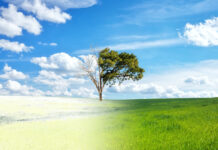Landscape professionals play a crucial role in educating their clients on the value and many benefits their trees, shrubs and ornamental plants provide even in the face of a severe drought. This includes informing clients of the expense of removing these plants, especially trees, should they die because of drought stress.
California landscape water use accounts for only 9 percent of the total statewide water use, point out Donald R. Hodel and Dennis R. Pittenger, both with University of California Cooperative Extension, in a recent publication entitled “9% The California Drought and Landscape Water Use.”
The two extension experts expand the focus of their attention beyond turfgrass. They point out many trees and shrubs depend on lawn irrigation to meet their water needs. They will suffer, decline and may die when irrigation is reduced or turned off because they depend on the frequent but shallow irrigation typically applied to home lawns. The roots of trees and shrubs grow horizontally and seldom more than 18 to 20 inches deep. They count on water near the surface of the soil to stay green and healthy.
Most property owners do not realize trees compete with turfgrass for moisture and nutrients. They do not realize trees and shrubs will require supplemental irrigation to remain alive until the drought ends. This is particularly true for non-native species, such as birch, although evergreens may show signs of decline earlier because they are green year-round. It’s up to the landscape pros who regularly visit these properties to look for signs valuable trees are in decline.
In most cases, property owners can water and save their trees, while still meeting irrigation restrictions, write Hodel and Pittenger. Homeowners can water trees using drip irrigation, soaker hoses or deep-root water probes. The goal is to irrigate the soil to a depth of 12 to 18 inches. Often a soaker hose or drip emitter must be left on for hours to get the water down to the plants’ roots. In most cases the amount of water used is minimal. Some professionals also use soil surfactants to make water’s journey to plant roots more efficient.
Apply mulch around the base of trees to save water but apply the proper amount. Avoid “volcano” mulching. Pull the grass and weeds from the area around the roots, and place mulch (about 3 to 4 inches deep) from the tree’s root flare to its drip line. In most cases you will not have to put new mulch around the tree for a year or more. To make the old mulch look fresh again, rake it and reshape it.
“Landscape plants—trees, shrubs, groundcovers, lawns and flowers—and the water they use are under unrelenting attack,” write Hodel and Pittenger. “However, most of these attacks are misguided when one looks at the facts.”
The authors claim water use research over the past 30 years has shown property owners can have their landscape plants, including functional lawns, meet water reduction goals and still have the numerous amenities, functions and quality of life benefits that landscape plants provide.
The bottom line is trees and other landscape plants are worthwhile investments, and the benefits they provide to homeowners and communities justify their water use … even during a drought.











![[VIDEO] Dickies®: Discover Workwear That’s Anything But Uniform](https://turfmagazine.com/wp-content/uploads/2023/06/1647663814-4b1a2a7742790a9b1e97a3b963477850192e1d6a9dfba9b07214a77bae25d6e3-d-218x150.jpg)



























![[VIDEO] Dickies®: Discover Workwear That’s Anything But Uniform](https://turfmagazine.com/wp-content/uploads/2023/06/1647663814-4b1a2a7742790a9b1e97a3b963477850192e1d6a9dfba9b07214a77bae25d6e3-d-324x160.jpg)